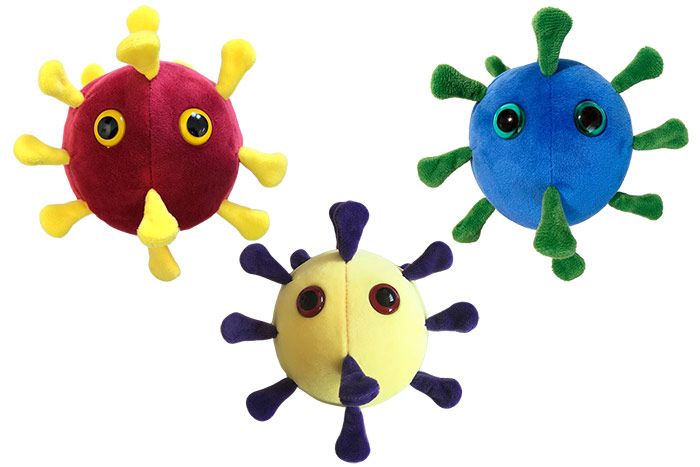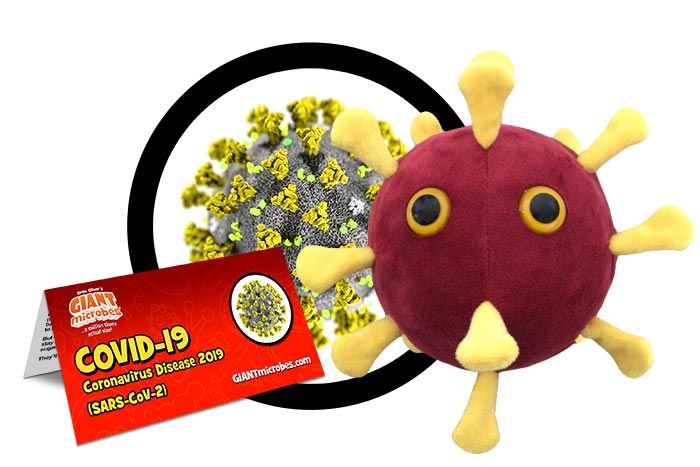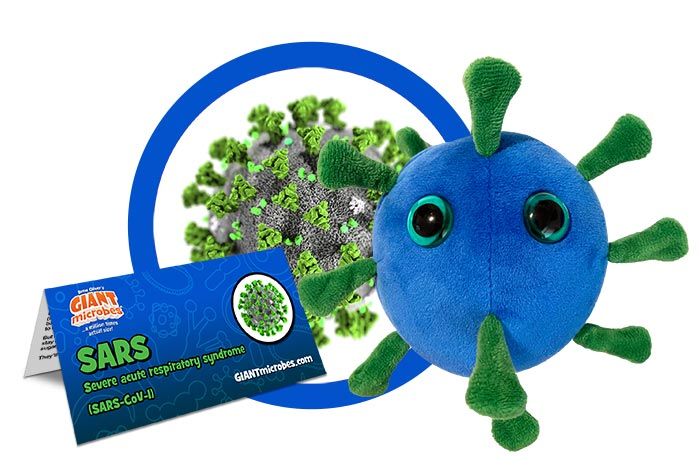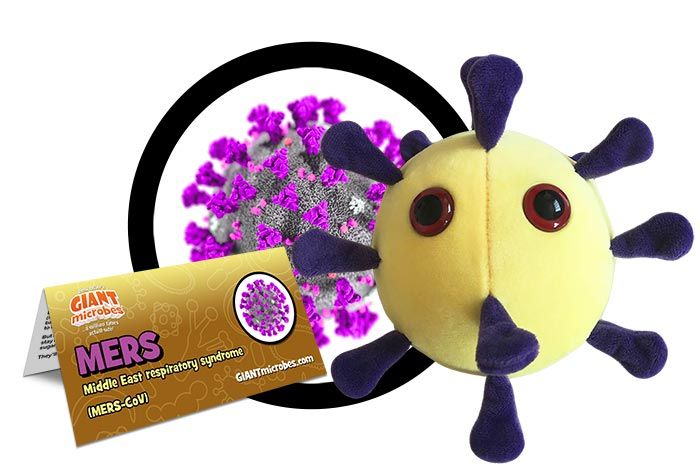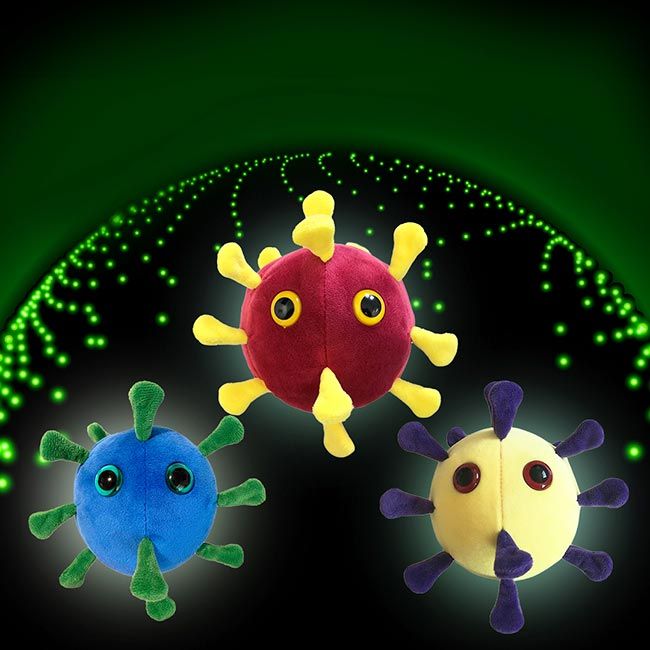Coronavirus Sisters 3-pack
Out of Stock
Years before COVID-19 arose to plague our world, SARS and MERS were the first coronavirus epidemics to inflict serious illness upon people. Microbes are truly amazing and mostly good – necessary for our bodies and Earth. But when it comes to the struggle against diseases such as SARS, MERS and COVID-19, it often comes down to human brains versus microbe genes. If we want to flourish, we must learn and respect the world of microbes.
Product Details
Additional Information
| Sizes | Giantmicrobes are based on actual microbes, cells, organisms and other critters, only 1,000,000 times actual size! Gigantic (GG) 16-24" XL (XL) 10-15" Original (PD) 5-8" Keychain (KC) 2-4" with clip |
|---|---|
| Materials | Plush from all new materials. Stuffed with polyester fiber fill. Surface washable: sponge with water & soap, air dry. |
| Packaging | Each plush microbe includes a printed card with fun, educational and fascinating facts about the actual microbe or cell. |
| Safety | Every product meets or exceeds U.S. and European standards for safety. For ages 3 and up. |
All about Coronavirus Sisters 3-pack
COVID-19: Cities are locked down, schools and businesses are closed, economies quiver and thousands of people are quarantined. The World Health Organization declares a global pandemic. This is the face of the coronavirus disease named COVID-19.
Identified in 2019 in China, COVID-19 quickly spread around the world during 2020. Spreading along with it: confusion, rumors and fear. Even at the end of 2020, much about this virus remains unclear. Compared to the seasonal flu, COVID-19 is more contagious and has a higher fatality rate. Scientists and public health experts scramble to confront it with 21st century therapies and vaccines. Meanwhile, governments “go medieval” by closing borders and isolating citizens inside their tainted towns. What should you do when a mysterious microbe comes knocking and the threat of a modern day plague is in the air? Start by staying calm and learning the facts.
The name COVID-19 stands for coronavirus and disease. Corona is for its crown-like protein spikes. The virus itself is named SARS-CoV-2. Coronaviruses are zoonotic, jumping from animals to humans. Many originate in bats. SARS was transmitted by civets, MERS by camels, and COVID-19 likely by animals sold in wildlife food markets. With contagious microbes, you are often at the mercy of nature and the interconnectedness of our world.
COVID-19 spreads from person-to-person through respiratory droplets carried in coughs or sneezes. It may also be transmitted by touching your mouth, eyes or nose after touching contaminated metal, plastic and other hard surfaces on which a virus can survive the longest. People are most contagious when showing signs of sickness, yet the virus can spread before symptoms occur. Symptoms may appear 2 to 14 days after exposure and can include fever, cough and shortness of breath. Some have no symptoms at all. The best way to prevent illness is to minimize exposure with common-sense measures. Avoid close contact with people who are sick. Do not touch your eyes, nose and mouth. Stay home when sick. Cover your cough and sneeze with a tissue. Disinfect frequently touched surfaces. Wash your hands often with soap and water. Wear a face mask to help protect yourself, protect others and slow the spread of COVID-19.
Microbes are remarkable and mostly good - vital to our bodies and our planet. However, when it comes to the struggle against black death, malaria, flu and other diseases such as COVID-19, it is human wits versus microbe genes. If we want to triumph, we must think clearly, learn, prepare and respect the microbe world.
SARS: Years before COVID-19 arose to plague our world, the first coronavirus epidemic to inflict serious illness upon people was SARS, severe acute respiratory syndrome. In 2003 the virus that causes this respiratory illness jumped from its animal host to humans. This disease started in China and then spread to 32 countries, infecting over 8,000 people and killing 774, mostly in Asia. In North America, Europe, Australia, Africa and Latin America, there was no community spread and very few cases of SARS. This is certainly not the case with the COVID-19 pandemic.
As with the coronavirus that causes COVID-19, the SARS virus is transmitted primarily through close person-to-person contact in droplets produced when a person coughs, sneezes or otherwise exhales viral particles. The symptoms of SARS are also similar to some of those for COVID-19, including high fever, body aches, shortness of breath and a dry cough. SARS is highly contagious and most dangerous to those with a compromised immune system. COVID-19 has spread in many types of locations, yet the vast majority of SARS cases were attributed to the lack of proper infectious disease control prevention in healthcare settings.
SARS was deadly but it did not become a global pandemic. Scientists were quick to identify this novel virus and health experts were efficient in isolating cases. Following the 2003 outbreak, there have been four known reappearances of SARS. Three were related to laboratories and the other was likely due to animal-to-human transmission. With SARS, humanity was also lucky. That coronavirus vanished and was nearly forgotten, that is until its cousin arose in a much bigger way to cause the COVID-19 pandemic.
Microbes are truly amazing and primarily they are good – necessary to our bodies and the planet Earth. But when it comes to the struggle against malaria, cholera, flu, measles and coronavirus diseases such as SARS and COVID-19, it often comes down to human brains versus microbe genes. If we want people to flourish, we must learn and respect the world of microbes.


